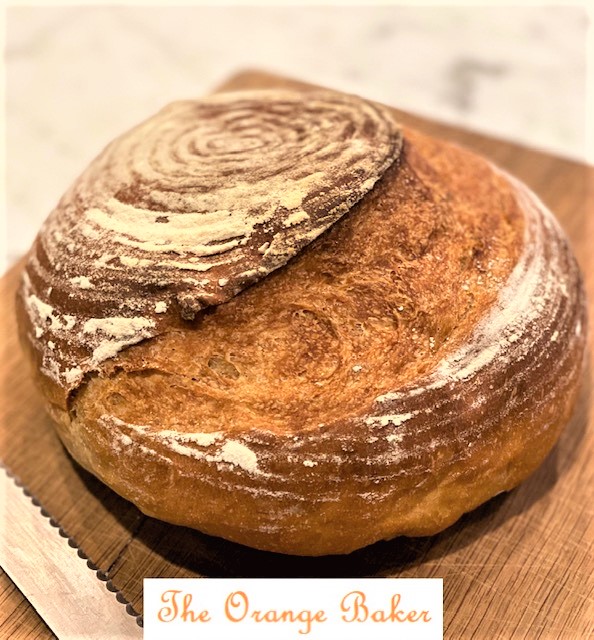Adding complexity in taste with something as easy as a starter
Disclosure: Some of the links in this post are affiliate links, meaning that, at no cost to you, I may earn a commission if you click through and make a purchase. Read more here.
The first time I made this bread I was sold. As a European, I have had my share of French, Italian and German breads, made based on sourdough, biga, sponge or poolish. It adds a lot of flavor and texture, and it is super-easy to make.
Quick Semi-Sourdough
Making a sourdough bread is not easy, if you don’t want to use instant sourdough yeast. But bakers agree: it tastes and looks much, much better. The aged starter you grow yourself add welcome complexity and flavors you whatever you bake. But, you may not have a sourdough bread, or you prefer to bake within a reasonable amount of time. We got you covered.
This recipe will give you an easy, perfect, rich bread, that will taste perfect when it’s fresh and makes a perfect toast, or croutons after a few days. Making it is not difficult, it just takes a little bit of time and planning. It is well worth it.
We use a poolish, which is a so-called wet sponge. The poolish acts as a starter, and is a mix of flour, water and a little bit of yeast. No salt, yet. You leave that mixture for at least 2 and up to 16 hours: the longer you leave it, the better the taste will be. Give it a try: I am sure you will love it.

French starter bread
Ingredients
The starter
- 250 milliliter Water
- 200 grams All-purpose flour
- 50 grams Whole wheat flour
- 5 grams Yeast
The bread
- 500 grams All-purpose flour
- 275 milliliter Water
- 10 grams Sugar
- 10 grams Salt
- 5 grams Yeast (Instant)
Instructions
Utensils
- Large bowl (at least 3 liters)
- Measuring cup, scale, small bowls
- Dough scraper
- Cling film or lid cover for bowl
- Baking sheet
- Baking parchment paper
- Baking tray or spray bottle
- Kitchen towel
Make the starter
- Stir all ingredients for the starter together in a bowl. It will form a smooth, thick mass, nothing like a regular dough, but that’s ok. Cover it up, and leave to work its magic. This will take at least 2 and preferably 4 hours, but you can leave it as long as 16 hours. It will have become all thick and bubbly and will smell sweet and bitter —that’s the yeast. The longer you leave it, the deeper and more complex the taste will be.
Make the bread
- In a big bowl, stir down the poolish, add 75% of the water, and all of the yeast, sugar, salt and the flour. Because the start transformed into a more or less cohesive mixture, it will look funny at the start, but continue, it will mix. Knead until you have a nice dough. You will use nearly all, or all of the water, but again, do not use all if you feel the dough is already quite wet. When you knead, the dough will become tougher anyway, as the flour will absorb the water.
Kneading
- You will have to knead for 10 to 12 minutes, until the dough is smooth, soft and shiny. When you grab a piece and pull it, it should form a ‘window pane’ of about half a centimeter thick, and not rip too easily. That is the gluten, and that is what you want.
First proofing
- Put the dough in a slightly greased bowl and set on a warm spot for the first proofing. Cover with a lid or a moist cloth. That will take roughly 1 – 2 hours. The dough will double in size.
Preparation and second proofing
- When you are happy with the first proofing, use the dough scraper to release the dough from the bowl, and carefully flick the dough on your counter top. Carefully push out some of the bubbles. Not all, you will want to keep holes in the dough, for the big bubbles we are after in this particular bread. Carefully —again — cut the dough into 2 or 3 equally sized pieces. Place the pieces on a metal baking sheet, lined with baking paper that can withstand high temperatures. Leave plenty of room between the breads. Cover with a kitchen cloth and set aside for the second proofing, of about an hour.
Baking
- After roughly 50 minutes, pre-heat the oven to 230°C/450°F/Gas Mark 8. When the oven reaches the preset temperature, take the breads and with a very sharp knife, make quick lacerations. These cuts act as vents, allowing vapor to escape, and preventing your bread to ‘cook’ from the inside. Dust the breads with a bit of flour and place in the oven.
- Immediately lower the oven temperature to 200°C/400°F/Gas Mark 6. For the first 10 minutes, using your spray bottle, spray a mist of water on the breads. Remember: mist, and no jet streams in the oven or the light will pop. The first couple of minutes, be very careful when opening the oven door to prevent to shock the dough, because it will deflate. After 10 minutes, spritz every 2 minutes.
- Bake the bread for 22-25 minutes. It will be ready when the top is golden, dark brown, and the bottom, too. When you tap the bread, it should sound hollow. When it is ready, take out of the oven and place the breads on a cooling rack right away. During this time, your breads will lose even more vapor. Allow for it to cool off before you cut it.
